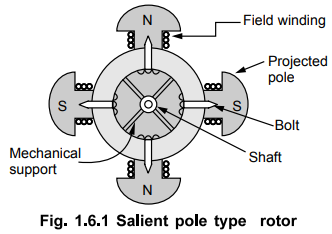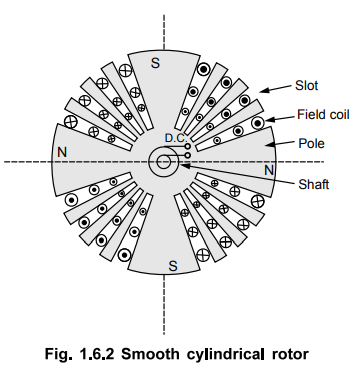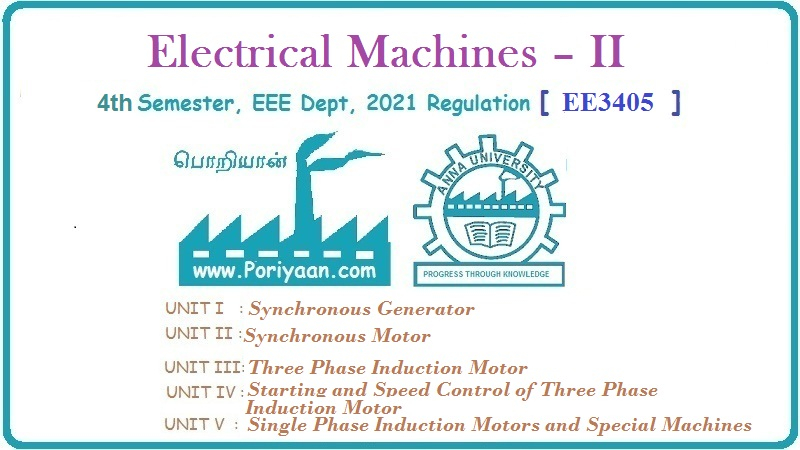Electrical Machines II: UNIT I: a. Synchronous Generator
Rotor
Construction, Working Principle | Synchronous Generator
There are two types of rotors used in alternators : 1) Salient pole type 2) Smooth cylindrical type.
Rotor
There
are two types of rotors used in alternators
1)
Salient pole type
2)
Smooth cylindrical type.
1. Salient Pole Type
This
is also called projected pole type as all the poles are projected out from
the surface of the rotor.
The
poles are built up of thick steel laminations. The poles are bolted to the
rotor as shown in the Fig. 1.6.1.

The
pole face has been given a specific shape. The field winding is provided on the
pole shoe. These rotors have large diameters and small axial lengths. The
limiting factor for the size of the rotor is the centrifugal force acting on the
rotating member of the machine. As mechanical strength of salient pole type is
less, this is preferred for low speed alternators ranging from 125 r.p.m. to
500 r.p.m. The prime movers used to drive such rotor are generally water
turbines and I.C. engines.
2. Smooth Cyllndrical Type
This
is also called non salient type or non-projected pole type of rotor.
The
rotor consists of smooth solid steel cylinder, having number of slots to
accommodate the field coil. The slots are covered at the top with the help of
steel or manganese wedges. The unslotted portions of the cylinder itself act as
the poles. The poles are not projecting out and the surface of the rotor is
smooth which maintains uniform air gap between stator and the rotor. These
rotors have small diameters and large axial lengths. This is to keep peripheral
speed within limits. The main advantage of this type is that these are
mechanically very strong and thus preferred for high speed alternators ranging
between 1500 to 3000 r.p.m. Such high speed alternators are called
'turboaltemators'. The prime movers used to drive such type of rotors are
generally steam turbines, electric motors.
The
Fig. 1.6.2 shows smooth cylindrical type of rotor.

Let
us list down the differences between the two types in tabular form.
3. Difference between Salient and Cylindrical Type of Rotor
Salient
Pole Type
1.
Poles are projecting out from the surface.
2.
Air gap is non uniform.
3.
Diameter is high and axial length is small.
4.
Mechanically weak.
5.
Preferred for low speed alternators.
6.
Prime mover used are water turbines, I.C. engines.
7.
For same size, the rating is smaller than cylindrical type.
8.
Separate damper winding is provided.
Smooth
Cylindrical Type
1.
portion of the cylinder acts as poles hence poles are non projecting.
2.
Air gap is uniform due to smooth cylindrical periphery.
Small
diameter and large axial length is the feature.
4.
Mechanically robust.
5.
Preferred for high speed alternators .e. for turboaltemators.
6.
Prime movers used are steam turbines, electric motors.
7.
For same size, rating is higher than salient pole type.
8.
Separate damper winding is not necessary.
Review Questions
1. List the differences between salient type and non salient
type of rotor construction. Give the constructional details of two of
alternators.
2. Give the constructional details of two types of alternators. AU
: May-03, 05, Dec.-06, 12, 14, Marks 8
3. Describe with neat sketches, the constructional details of a
salient pole type alternator. AU : Dec -16, May-18, Marks 10
Electrical Machines II: UNIT I: a. Synchronous Generator : Tag: Engineering Electrical Machines - II : Construction, Working Principle | Synchronous Generator - Rotor
Related Topics
Related Subjects
Electrical Machines II
EE3405 Machine 2 EM 2 4th Semester EEE Dept | 2021 Regulation | 4th Semester EEE Dept 2021 Regulation
